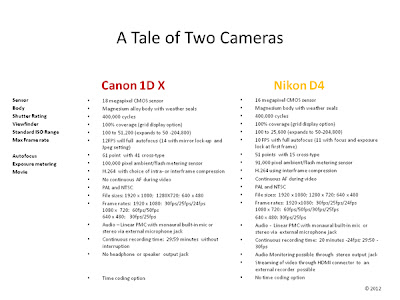The big story in imaging for 2011 was in the ILML camera segment: 14 new cameras were introduced last year. The trend seems to be continuing in 2012 with Olympus expanding its ILML camera line with the OM-D E-M5 as well as a fast telephoto prime and macro lens; Fujifilm announcing the X-Pro 1 and several lenses; and Pentax-Ricoh announcing the K-O1, the companies second ILML model but the first of the mirror-less cameras to work with a manufacturers existing DSLR lenses without an adapter. With Fujifilm’s entry into this market, there are now seven manufacturers using four sensor formats; and seven different systems and lens mounts. The price range of $400 to $1700 for an ILML body, suggest that some manufacturers believe the appeal of smaller bodied, high quality camera systems goes beyond amateurs and enthusiast moving up from point & shoot and “advanced” compact cameras. The chart below profiles the available ILML camera systems.

The Micro Four Thirds format used by Olympus and Panasonic, as well as the Sony NEX format got a huge boost with Sigma’s announcement that it would be producing lenses for both formats and news that Tamron and Tokina, the other two large third-party lens manufacturers have joined the Micro Four Thirds Group.
Since the Micro Four Thirds system used by Panasonic and Olympus is the oldest of the ILML camera systems, it should come as no surprise that the format is leading the pack in terms of lens availability with more than 28 OEM lenses developed specifically for the system available; and covering an effective focal length range of 14 to 600mm. Although Panasonic and Olympus use the same format and mount, Olympus lenses are not image-stabilized since the Pen system uses body-based image stabilization; Panasonic, on the other hand, uses lens-based stabilization. Many of the Olympus and Panasonic lenses are silent -focusing and are therefore optimized for use in conjunction with autofocus during motion capture.
The announcement and availability of an increasing number of large aperture primes from many of the ILML camera makers addresses what some believed was the Achilles Heel of the segment in general. With the addition of these lenses, many ILML cameras— particularly those using the larger sensor formats— will offer the same depth of field control options and low light capabilities as HDSLs using the same sensor format.
While the Leica M9 is technically an ILML camera, it has not been listed as it does not have video capability. Leica is expected to unveil a new compact ILML camera system during the second half of 2012. As of this writing, Canon remains the sole major camera manufacturer yet to enter this growing and increasingly competitive segment of the imaging market.
While the ILMC segments continue to expand, point &shoot and advanced cameras remain an important segment in the imaging market with 65 new cameras being announced since January 1.






